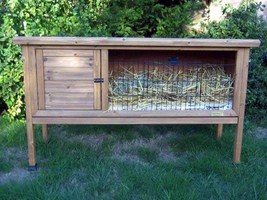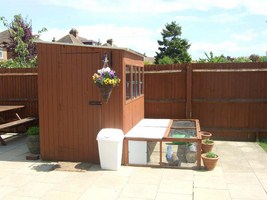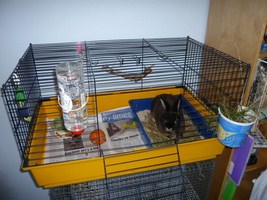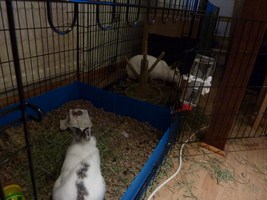This page contains useful advice on rabbit care. Providing tips on many areas from accomodation to healthcare. If you would like more advice on your rabbits care and health, then please make an appointment with one of our veterinary nurses. Rabbits are the UKs third most popular pet. Sadly they are also often the most misunderstood. Rabbits love to have space to run and exhibit natural behaviours such as digging.
Many cages and hutches sold in pet shops are unsuitable for rabbits and are below the minimum recommended housing size of 6’x2’x2’ with an attached run of 8’x4’. You can even have a rabbit living in your house the same as a dog or cat!
Rabbits will express their joy through ‘binkying’, a sign of a happy and contented rabbit!
Outdoor Accomodation
An example of an unsuitable sized hutch:

This hutch is just 3 feet long and 1.4 feet wide. A rabbit should have space for 3 hops; an average sized rabbit can cover 6-7 feet in 3 hops! Rabbits stand on their back legs and ‘periscope’ to look at their surroundings, a hutch this size would not allow them to do this.
A much better form of outdoor accommodation would be to convert a garden shed and attach a run:

Sheds can be easily converted with the addition of a cat flap to allow access to the run. Lino can be placed on the floor for easy cleaning.
Indoor Accomodation
An example of an unsuitable sized cage:

A cage this size would only be suitable for a rabbit recovering after an operation. Rabbits enjoy space to roam and explore, a rabbit in a cage of this size would become bored and frustrated.
A better option would be a dog crate with a run attached:

Try to buy the biggest crate you can, either a ‘large’ or ‘giant’. The run can be constructed from puppy panels. The panels are attached to the crate with cable ties with the door to the run kept permanently open. The tray in the crate is made of correx, this stops bedding been kicked over the side. Correx can be bought from sign makers.
Free Ranging
Free ranging means no crate, cage or hutch. You could even have a room dedicated to your rabbit. Or you could just allow your rabbit access when you are able to supervise them and allow them access to a secure crate and run when unsupervised. You will have to ensure the area is bunny proofed. This means moving everything that you wouldn’t want chewed! Cable tidies will protect cables that can’t be hidden away. Most house plants are toxic to rabbits so should be removed. Ensure your rabbit has access to a safe area to sleep and rest in. Rabbits are generally clean animals and can be litter trained.
Rabbits will often tolerate living with other pets in the household.
Garden Rabbits
Rabbits can also be allowed to free range in the garden. They should only free range in the garden when supervised and housed in a shed or hutch with a run attached when unsupervised.
Before allowing your rabbit to free range in the garden ensure there are no gaps in the fence they can fit through and watch out for them digging. Also check for poisonous plants and weeds.
Enrichment
There are many toys that you can buy to keep rabbits entertained. Favourites are balls made out of materials such as willow or seagrass.
Toys can also be homemade – fill toilet roll tubes with hay, put hay inside a cardboard egg box and close it up or even just scrunch a few sheets of newspaper into a ball! Rabbits also enjoy chewing and fruit tree prunings are ideal and keep their teeth trim.
Rabbits also love to dig so try filling a sturdy box or even a plant pot with earth. Tunnels recreate a rabbit’s natural environment and they enjoy running through them and lying down inside them.
Two Rabbits Are Better Than One
Rabbits naturally live in large groups and are much happier with their own kind. Rabbits shouldn’t be kept with guinea pigs as they have different dietary requirements and rabbits’ strong back legs can injure a guinea pig if they kick out. The best combination is a neutered male (buck) and neutered female (doe).
When introducing two rabbits make sure it is on neutral territory. Clean everything with dilute bleach or white vinegar. Start off introducing them in a small space of 4 to 6 foot by 2 foot. Gradually increase the space over a few weeks until you reach the accommodation size you want. If getting another rabbit from a rescue a lot of rescues will offer a bonding service for you. This means you will leave your rabbit with them for about a week and take them home once the bond is complete.
Diet
Rabbits should eat hay, hay and more hay! Their diet should be at least 70% hay. Hay helps to keep their teeth worn down and prevents dental problems.
The greener and sweeter smelling the hay the better. Alfalfa hay should only be given as a treat as it is high in calcium. Rabbits should only be fed a small amount of dried pellets (about an egg cup full) a day. Avoid cereal mix food as this encourages selective eating. Rabbits enjoy eating herbs such as parsley, dill and basil and leafy greens such as spring greens. Carrot should only be fed in small amounts. Avoid commercial treats as they are high in sugar; instead feed a small slice of banana or a different type of hay. You can even forage food for your rabbit such as dandelion and hawthorn leaves.
Healthcare
Rabbits should be vaccinated against Myxomatosis and VHD. Myxomatosis should be given every 6 months and VHD annually.
You should give your rabbit a regular health check.
- Fur checked for signs of dandruff
- Nose and eyes checked for discharge
- Tail and bottom checked for soiling. A soiled bottom area can encourage flies to lay eggs and maggots to hatch. This is known as ‘fly strike’. A very serious condition requiring immediate attention from a vet
- Teeth continuously grow. If your rabbit is dribbling, losing weight and having trouble eating this could be caused by its teeth. A vet will need to examine the rabbit
- Check feet for redness and broken skin. The Rex breed are pre disposed to sore hocks so regular checking and deep comfy bedding is essential.
- Nails need to be clipped regularly, a nurse can do this for you or you can trim them yourself at home.
- If you notice your rabbit isn’t eating and is sitting in a hunched uncomfortable position and grinding their teeth they could have gut stasis and require immediate veterinary attention.
Useful Links
Rabbit Welfare Association and Fund
Rabbits United
Hay Experts
Rabbit Rehome
HAPPY BUNNY OWNERSHIP!
Have fun with your rabbits, they make great members of the family and will provide you with hours of entertainment. Although hard work at times it is worth it when you see your rabbit asleep and content or racing around the living room causing mayhem!